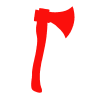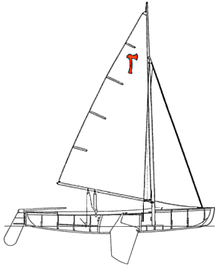Pirate (boat class)
| Notation | |
|---|---|

|
|
| Boat dimensions | |
| Length above : | 5.0 m |
| Length WL : | approx. 4.68 m |
| Width above sea level : | 1.61 m |
| Draft : | 0.20 - 1.05 m |
| Mast height : | 6.29 m / above deck: 5.86 m |
| Weight (ready to sail): | 218 kg |
| Sail area | |
| Sail area close to the wind : | 10 m² |
| Mainsail : | 7.28 m² |
| Jib : | 2.72 m² |
| Others | |
| Rigging type: | Sloop |
| Yardstick number : | 110 (GFK) / 112 (wood with aluminum mast) or 116 (wood with wooden mast) |
| Class : | national |

The pirate , a 5 m long chine - dinghy m² with 10 sail area, was drawn in 1938 by the German dinghy designer Carl Martens, so a competition of "magazine Yacht won". Originally the boat was called "10 m² unit youth dinghy". The name "Pirat" was then determined in accordance with the American custom of choosing lyrical boat names, also through a competition held by this magazine.
In the following years the pirate became the most built solid wooden sailboat in Germany. Since the 1960s, the boat hull has also been made of fiberglass-reinforced plastic , sandwich construction or plywood . According to the class rules , boats made of aramid and carbon fiber reinforced plastic are prohibited.
Through innovations such as Spinnaker , aluminum - rig the survival of the pirates was as popular and other technical refinements boat class backed up to the present time. So far over 6,000 boats have been built in Germany alone.
Construction method for wooden boats
The classic pirates in solid wood construction are clad with kraweel . The plank joints are usually covered with seam strips on the inside board. The frame position is very narrow (43 cm) and, in combination with the floor walls, gives the boat hull a high torsional stiffness. This construction, in unity with the hard chine profile of the hull, is the reason for the robustness and long service life of the Holzpiraten.
The keel of the Pirats, the stem and the stem knees, behind the mirror attached eighth Steve-like reinforcement, which joists , floor timbers and Kimmstringer , and the sword box walls are made of oak manufactured. The underwater hull , the side planking, the transom and the deck are usually made of Gabon wood ( mahogany ). The main mast and the main boom are made of spruce wood. The sword and the vertically swiveling rudder blade (lowering rudder) are made of sheet steel or ash plywood . However, if the rudder system is made entirely of wood, the rudder blade is i. A. not foldable.
Construction method used by GRP pirates
Today the Pirate is manufactured exclusively in plastic as standard. The hull is mainly made of sandwich construction and the deck is made of wood or GRP construction. Since there is such a large difference in weight in the individual boats, the difference to the standard size is compensated for by weights within the boat hull . In the past, the sword was mostly made of steel, painted or galvanized to prevent rusting. Today stainless steel is preferred. Wooden or plastic swords are not permitted according to the building regulations (rule 9.1 of the building regulations).
The sails
The pirate is a slup-rigged dinghy . The maximum sail area upwind , consisting of the areas of the mainsail and foresail , is 10 m² according to the class regulations. The area of the spinnaker, which has been permitted since the 1960s , must also not exceed 10 m². The use of genoa or gennaker is not permitted according to the class regulations. According to the original rigging regulations for the pirate, it was possible to drive a so-called " balloon sail", a larger balloon-shaped jib with a sail area of 3.70 m². The sails can be made of natural or synthetic fabrics according to the class rules. Normally the sails these days are made of polyester fibers, mainly from the material " Dacron ". Carbon fibers in the sails are forbidden according to the class rules and may only be used as reinforcement in the windows of the sail.
Sailing with the pirate
The pirate is a youth dinghy. It was designed for sailing in inland areas, but is also ideal for regatta sailing in coastal areas of the Baltic Sea, the Mediterranean Sea and the Atlantic. The wooden pirates were popular cruising sailboats in the past. Modern racing pirates made of plastic are now used almost exclusively as regatta boats.
crew
The boat crew consists of two people, the helmsman and the bow . Sailing in a trapeze is not allowed according to class regulations. In fresher winds, the pirate is difficult to sail upright for light crews and a good trim is required to be able to drive this dinghy quickly and successfully. In good sail trim and optimal positioning of the crew in the boat race pirates have to Raumschotkursen from 4 Bft . good sliding properties despite the chine construction .
Race and regatta
Regattas are sailed with the pirate as long as he is around. It used to be the only class in which German youth championships were held. The class currently has more than 380 participants in the official ranking list in Germany alone, making it one of the most active regatta classes in Germany. Annually u. a. around 70 ranked regattas (national and international) held in Germany. Internationally there are currently 216 ranking regattas. The pirate is run by the German Sailing Association as a national standard class and as a youth class.
There are active regattas in Germany, Bulgaria, Denmark, Austria, Poland, the Czech Republic, Switzerland, Hungary, Turkey and Chile. Different championships are sailed with the pirate in Germany every year. In many federal states there is a state championship and a state youth championship (U19), in which the U17 champions are determined at the same time. In the course of one week, the German champions are determined annually at the IDM (International German Championship) and the youth and U17 championship titles are awarded at the IDJM (International German Youth Championship). In recent years, the pirate, especially as a youth boat, has faced strong competition from the more modern dinghy classes such as the 420 and 29er.
The most successful German pirate sailor, as a twenty-time German champion, three-time European champion and simple world champion, is Frank Schönfeldt from Hamburg, who also became known outside of the class thanks to his successes.
Sail sign
The pirate's sailing symbol is a red hatchet , also known as a “cleaver”, with a curved handle pointing downwards and a blade pointing towards the luff . Today's class emblem was created from earlier, more ornate forms with a straight stem.
gallery
See also
Web links
- IPA International Pirate Association
- German Pirate Class Association e. V.
- Austrian pirate class association
- Swiss Pirate Association
- holzpirat.org - Extensive information collection on wood pirates, pictures from the festival of wood pirates since 2004
Individual evidence
- ↑ DSV yardstick figures 2017 . (PDF; 837 kB) ( Page no longer available , search in web archives ) Info: The link was automatically marked as defective. Please check the link according to the instructions and then remove this notice. dsv.org, p. 4; accessed on June 2, 2017
- ↑ Bernd Klabunde: The “Pirat” dinghy turns 75 . On March 6, 2013 from holzpirat.org, accessed on March 4, 2017



